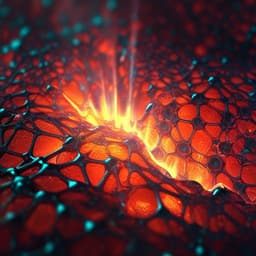
Physics
Direct nano-imaging of light-matter interactions in nanoscale excitonic emitters
K. Jo, E. Marino, et al.
Discover how localized nanoscale emitters on Au substrates enable unprecedented control of light-matter interactions through innovative near-field nano-spectroscopic studies. Conducted by leading researchers including Kiyoung Jo and Emanuele Marino, this breakthrough reveals standing-wave patterns and offers new insights into nano and quantum photonics.
~3 min • Beginner • English
Introduction
The study addresses how nanoscale excitonic emitters couple to and launch in-plane electromagnetic modes at interfaces, and whether these processes can be directly imaged and quantified in the optical near-field. In strongly confined, resonant systems, light-matter coupling forms polaritons (plasmon-, exciton-, and phonon-polaritons) that require subwavelength confinement to efficiently interact with dipoles. Surface plasmon polaritons (SPPs) confine light at dielectric/metal interfaces and can propagate along the surface, while exciton-polaritons form when optical resonances overlap with cavity-confined light. Reduced-dimensional materials exhibit large exciton binding energies and strong light-matter interactions, making them ideal testbeds.
Despite extensive far-field spectroscopic studies and non-optical approaches, direct near-field imaging of strong light-matter coupling and of in-plane energy transduction from nanoscale emitters at optical frequencies remains scarce. Tip-enhanced nano-spectroscopy enables subwavelength mapping of emission from nanostructures, but most emission studies use contact mode, probing primarily out-of-plane gap-mode coupling. The role of tapping-mode tips in imaging in-plane emission or scattering has been less explored. This work aims to visualize and analyze in-plane, near-field radiation and SPP propagation launched by excitonic emitters using tapping-mode tip-enhanced photoluminescence (TEPL), and to determine how dielectric environment and emitter dipole orientation govern the observed interference fringes and energy transfer.
Literature Review
Prior work has demonstrated strong light-matter coupling and polariton phenomena in various systems, including exciton-polaritons in 2D semiconductors (e.g., MoS2 in optical cavities), exciton–plasmon polaritons in WSe2, quantum dots in plasmonic cavities, and SPPs at MoS2/Al2O3/Au interfaces. Imaging propagating polariton modes has been achieved using scattering-type nano-optical probes and microcavity-based approaches. Near-field tip-enhanced techniques have mapped fluorescence and Raman responses at the nanoscale, including quantum dot emission patterns, strain effects, and localized excitons in 2D semiconductors. However, emission studies predominantly employed contact-mode gap enhancement, emphasizing out-of-plane coupling; tapping-mode emission imaging remains limited. Standing-wave interference of polaritons has been visualized via scattering-mode near-field microscopy (e.g., graphene SPPs, exciton-polaritons in WSe2, phonon-polaritons in hBN metasurfaces), where the tip often acts as the launcher. The gap identified by the authors is direct mapping of exciton-launched, in-plane SPPs at optical frequencies via tapping-mode TEPL and disentangling how emitter geometry, polarization, and dielectric environment control near-field fringe formation and propagation.
Methodology
Materials and sample preparation: Quasi-2D CdSe nanoplatelets (NPLs) of 4.5 monolayer thickness were synthesized following literature procedures, with detailed steps for cadmium myristate precursor preparation, Se-injection synthesis, and post-reaction workup. The nanoplatelets were purified via staged centrifugation to isolate the desired 4.5 ML fraction, verified by absorption peaks (512 nm for 4.5 ML vs 462 nm for 3.5 ML). Core/shell CdSe/Cd_xZn_1-xS NPLs were prepared by hot-injection of octanethiol precursors into a mixture containing cadmium and zinc oleate, followed by growth and washing to remove aggregates. Nanocrystals were characterized by TEM (JEOL 1400 and F200) and optical absorption (Cary 5000).
Substrate and dielectric stacks: Dispersions of CdSe/CdZnS NPLs (0.001 mg/mL in toluene) were spin-coated onto template-stripped Au substrates (rms ~0.5 nm). Dielectric films (Al2O3, TiO2) of controlled thickness were deposited by ALD (Cambridge Nanotech S200); refractive indices were measured by ellipsometry. Monolayer WSe2 was prepared by mechanical exfoliation on Au; ALD Al2O3 produced strain-induced nanobubbles acting as localized emitters. Additional dielectric waveguide structures were fabricated: TiO2 (10 nm)/NP on SiO2/Si with varying SiO2 thickness (e.g., 50 and 290 nm).
Near-field spectroscopy and imaging: Tip-enhanced photoluminescence (TEPL) was performed using a Horiba LabRam-EVO spectrometer coupled to an AIST-NT OmegaScope-R AFM. A 633 nm (1.96 eV) laser was focused at the Au tip apex; additional excitations (594 and 785 nm) were used for comparative studies. The AFM operated with frequency-modulated feedback; hyperspectral maps were acquired simultaneously in contact and tapping modes with 30×30 nm2 pixels and 100 ms/pixel integration. Near-field TEPL maps/spectra were extracted by subtracting contact-mode TEPL from tapping-mode TEPL to isolate the in-plane, tip-scattered contribution. Polarization-dependent measurements (TM vs TE) probed dipole selection rules.
Simulations and analysis: Finite element method (COMSOL Multiphysics) was used to simulate cross-sectional and 3D E-field distributions and SPP standing waves for dielectric/NP/Au stacks with and without the tip (tip-sample spacing ~20 nm in tapping mode). Simulations evaluated the roles of NP- and tip-launched SPPs, dipole orientation (out-of-plane vs inclined), dielectric permittivity and thickness, and polarization. Fourier analysis of fringe patterns provided SPP periods; decay constants were extracted by fitting antinode intensities to exponential decays. SPP dispersion (E–k) at dielectric/Au interfaces was calculated using a Lorentz–Drude model for Au and compared to experimental fringe-derived wavevectors.
Key Findings
- Tapping-mode TEPL directly images in-plane, exciton-launched SPPs as near-field fringe (standing-wave) patterns between the emitter and the metallic tip on dielectric/Au interfaces. Simulations show fringes emerge only when both NP and tip are present near the Au surface, with the tip acting primarily as a reflector/scatterer.
- Measured fringe periods agree with SPP dispersion: Fourier analysis gives ~317 nm period, consistent with expected ~320 nm at 664 nm emission. Standing-wave condition depends on tip–emitter separation.
- Geometry and dipole orientation control fringe formation: Edge-up NP clusters (thicker regions ~40 nm) exhibit boomerang-shaped fringes at 664 nm; face-down clusters (~12 nm) do not. This source selectivity reflects out-of-plane (edge-up) vs in-plane (face-down) transition dipole orientations.
- Polarization dependence: Under TM-polarized excitation, edge-up NPs launch SPPs and fringes are observed; TE polarization yields negligible in-plane SPPs. Thin NP clusters (~3 nm) do not show fringes; thicker clusters (>16 nm) do.
- Directionality and dipole inclination: Boomerang/parabolic fringe shapes indicate inclined dipoles; circular fringes correspond to out-of-plane dipoles (confirmed by simulations). Fringe period increases with azimuthal angle relative to the symmetry axis: ~322 nm at 0° to ~459 nm at 90°, with interference disappearing at high angles due to lack of cavity formation.
- Propagation length and decay: Fringes persist up to the 5th fringe (~1.7 µm) from the source. Decay constants (antinode intensity) depend on dielectric: Al2O3 (5 nm) 324 ± 0.01 nm; Al2O3 (0.7 nm) 234 ± 0.12 nm; TiO2 (5 nm) 468 ± 0.16 nm; monolayer WSe2 (0.7 nm) 417 ± 0.12 nm, indicating higher-ε media enhance confinement and extend propagation.
- Dielectric tuning of SPPs: Simulations show fringe period increases with decreasing dielectric permittivity and thickness. Experimental fringe periods (at ~664 nm emission): Al2O3 (5 nm) 322 nm; Al2O3 (0.7 nm) 329 ± 135 nm; WSe2 (0.7 nm) 325 ± 119 nm; TiO2 (5 nm) 313 ± 92 nm. Experimental E–k points align with calculated SPP dispersion; slight deviation for Al2O3 (0.7 nm) attributed to nonuniform ultrathin films.
- Universality across emitters and platforms: Strain-localized emitters in monolayer WSe2 nanobubbles (emission ~850 nm) launch circular fringes with 357 ± 163 nm period; WS2 nanobubbles also show SPP fringes at ~660 nm. Excitation-wavelength studies suggest fringes at 594 and 633 nm are dominated by exciton-launched SPPs, while at 785 nm laser-scattered SPP contributions can extend fringe periods. Simulations for WSe2 (790 nm dipole) yield ~380 nm period, matching experiment.
- Non-plasmonic guided-mode case: On TiO2(10 nm)/NP/SiO2/Si, fringe patterns at 663 nm arise from guided modes in SiO2, with experimental period 442 ± 230 nm (simulation 439 nm), demonstrating the method probes general in-plane light confinement beyond plasmonics.
- Tip contribution: Tip-launched SPPs exist but are 20–100× weaker than NP-tip fringes in simulations; fringe formation can be understood as interference between SPPs launched by the emitter and the tip, with emitter contribution dominant near resonance.
Discussion
The work demonstrates that tapping-mode TEPL can directly image in-plane near-field energy transduction from nanoscale excitonic emitters, addressing a key gap in visualizing strong light–matter interactions at deep-subwavelength scales. The observed standing-wave fringes originate from SPPs (or guided modes) launched by excitonic emission and reflected/scattered by the metallic tip, establishing a lateral cavity whose period and decay encode the mode dispersion and losses.
Control over fringe presence, shape, and extent arises from emitter dipole orientation (edge-up vs face-down NP assemblies), excitation polarization (TM vs TE), and the dielectric environment (permittivity and thickness). These dependencies validate the mechanism of in-plane coupling and provide a metrological handle to infer dipole orientations and mode properties from spatial photoluminescence maps. The quantitative agreement between measured fringe periods/dispersion and electromagnetic simulations, as well as the tunability across dielectrics and emitters (CdSe/CdZnS NPs, WSe2/WS2 nanobubbles), underscore the universality of the effect. The method preserves subwavelength resolution in tapping mode and separates exciton-launched from laser-scattered contributions by appropriate excitation energy choices.
These findings are significant for nano- and quantum-photonic device design, enabling engineered in-plane emission and mode confinement by dielectric tailoring and emitter geometry. They also offer a pathway to probe and manipulate dipole orientations and near-field coupling mechanisms in complex heterostructures.
Conclusion
By combining tapping-mode tip-enhanced nano-spectroscopy with electromagnetic simulations, the study provides direct, nanoscale visualization of in-plane surface-confined electromagnetic modes launched by localized excitonic emitters. Standing-wave fringe patterns reveal SPP (or guided-mode) propagation, with periods and decay constants governed by dielectric permittivity/thickness and emitter–tip geometry. The fringe shape encodes the emitter’s transition dipole orientation and directionality. The approach generalizes across materials systems, including colloidal CdSe/CdZnS nanoplatelets and strain-localized emitters in monolayer WSe2 and WS2, and applies to both plasmonic and dielectric waveguiding substrates.
Future work could leverage this technique to map and control quantum emitter dipoles, explore coherence and dephasing dynamics of exciton-launched polaritons, optimize dielectric architectures for enhanced in-plane emission, and integrate active tuning (electrical, strain, or phase-change materials) to dynamically modulate near-field energy transduction.
Limitations
Measured fringe parameters exhibit large uncertainties due to the lossy plasmonic cavity and decay of SPPs, limiting fringe visibility beyond ~1.7 µm from the source. Disentangling emitter- vs tip-launched SPP contributions can be challenging near resonance or for low-quantum-yield emitters; simulations suggest tip-launched SPPs are weaker but non-negligible. Ultrathin ALD dielectrics (<1 nm) may be non-uniform, affecting dispersion comparisons. The detection scheme filters the excitation wavelength, complicating assessment of laser-scattered SPPs unless their broadened tails enter the collection window. Quantitative analysis of absolute SPP amplitudes is sensitive to tip–sample spacing and geometry in tapping mode. The approach assumes highly smooth, index-mismatched interfaces; surface roughness or heterogeneous environments could degrade fringe formation and analysis.
Related Publications
Explore these studies to deepen your understanding of the subject.







